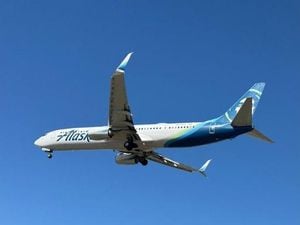An Airbus plane belonging to South Korean carrier Air Busan caught fire on Tuesday at Gimhae International Airport, located in the country’s southern region, as it was preparing for departure to Hong Kong. According to fire authorities, all 169 passengers and seven crew members were evacuated safely, though three reported minor injuries, with one person later requiring hospitalization.
The fire was reported just before 10:30 p.m. local time when flames erupted from the plane's tail. Eyewitness accounts described scenes of chaos as emergency workers deployed inflatable slides to facilitate passenger evacuations. Footage aired by local broadcaster YTN showcased the urgency of the situation, with emergency crews battling smoke and flames emanated from the single-aisle aircraft. Additional clips released by the Yonhap news agency revealed extensive damage, showing burned holes along the fuselage's roof.
This incident has raised alarms due to the close proximity of another tragic aviation event. Just one month prior, on December 28, 2024, South Korea endured its deadliest air disaster when a Jeju Air flight crash-landed at Muan Airport's runway after departing from Thailand. Tragically, of the 181 individuals aboard, only two survived.
The Airbus involved in the Gimhae incident was identified as a 17-year-old Airbus A321ceo model with the tail number HL7763, as listed by the Aviation Safety Network. According to CEO plans, the incident is under active investigation by South Korea's transportation ministry, with officials stating, "It is unclear when we will be able to disclose the investigation findings on the cause of last night’s fire." The transport ministry has acknowledged the potential cause may involve portable battery storage, as suggested by some local reports.
The South Korean aviation community remains on high alert following the last month’s Muan disaster, which has led to heightened scrutiny and calls for improved safety protocols across the board. Despite the evident danger posed by this recent fire, the wings and engines of the Air Busan aircraft were reportedly undamaged, illustrating both the effectiveness of the rapid response protocols and perhaps fortuitous circumstances surrounding the events of the evening.
Air Busan and its parent company, Korean Air, are yet to release formal comments addressing the incident directly, leading to speculation about internal safety practices and responses to such emergencies. Meanwhile, Airbus officials are monitoring the situation closely, stating, "We are aware of reports about the incident and are liaising with Air Busan." It appears the focus will primarily center on conducting thorough safety investigations and completing stranded passenger protocols.
While evacuation efforts were successful without catastrophic outcomes, the injuries reported amplify discussions about emergency preparedness on commercial flights. Seven confirmed injuries on board have made clear the need for comprehensive training for both flight crews and passengers to navigate unpredictable flight emergencies.
This recent event at Gimhae International Airport serves as another stark reminder of the potential dangers present within aviation—a sector plagued by complexity, even as advancements in technology and safety regulations persist. The international community continues to observe as details evolve from this incident, particularly the discovered link to portable batteries stored onboard.
With reports surfacing about passenger experiences and their feelings of vulnerability during such crises, these conversations will likely spark wider discussions about passenger safety, regulatory oversight, and necessary reforms among air carriers to prioritize traveler security above all.



